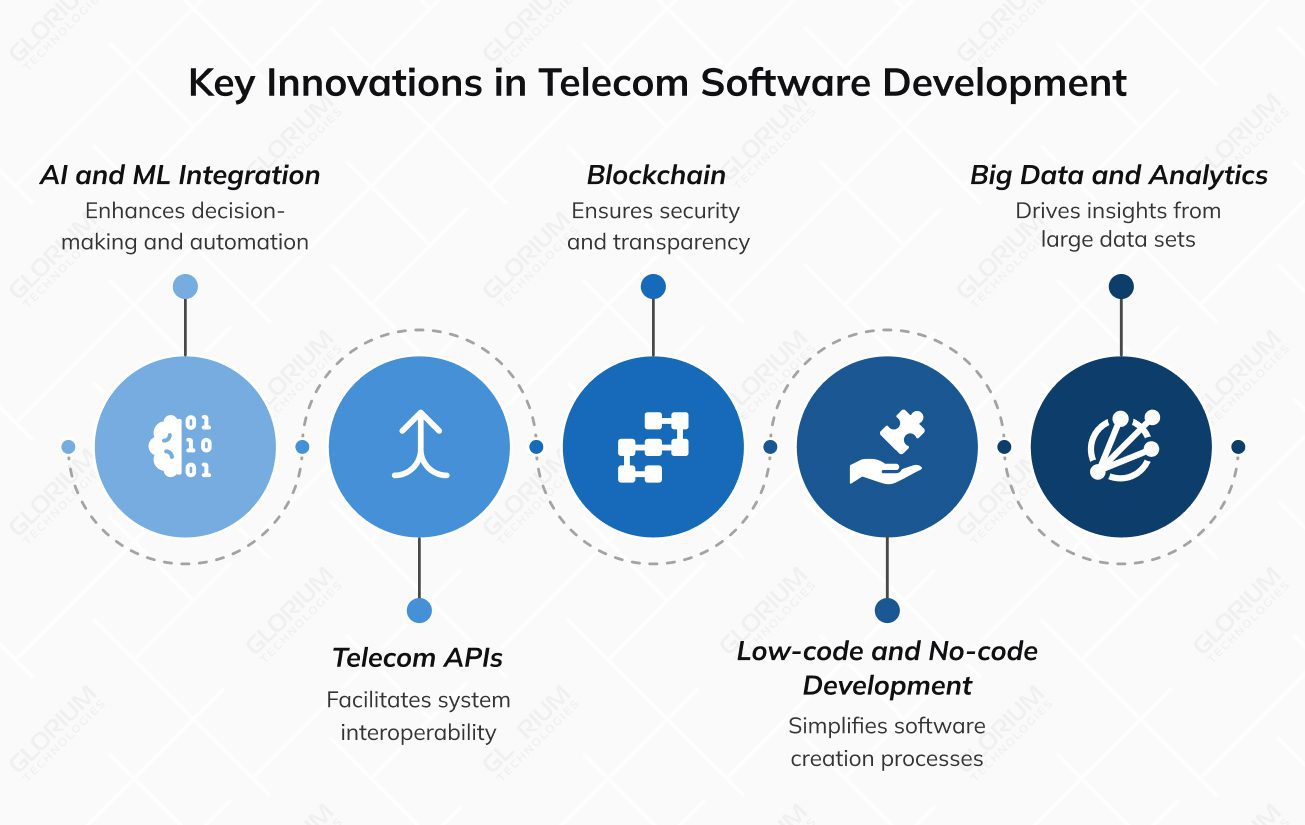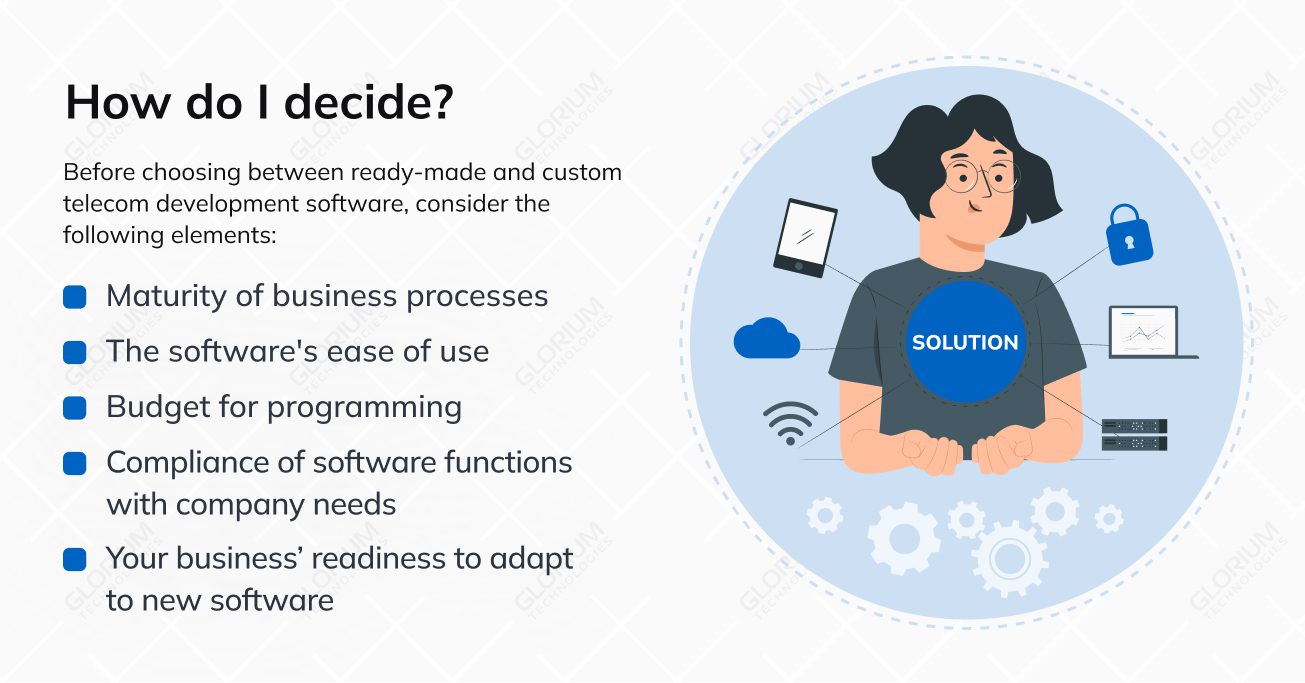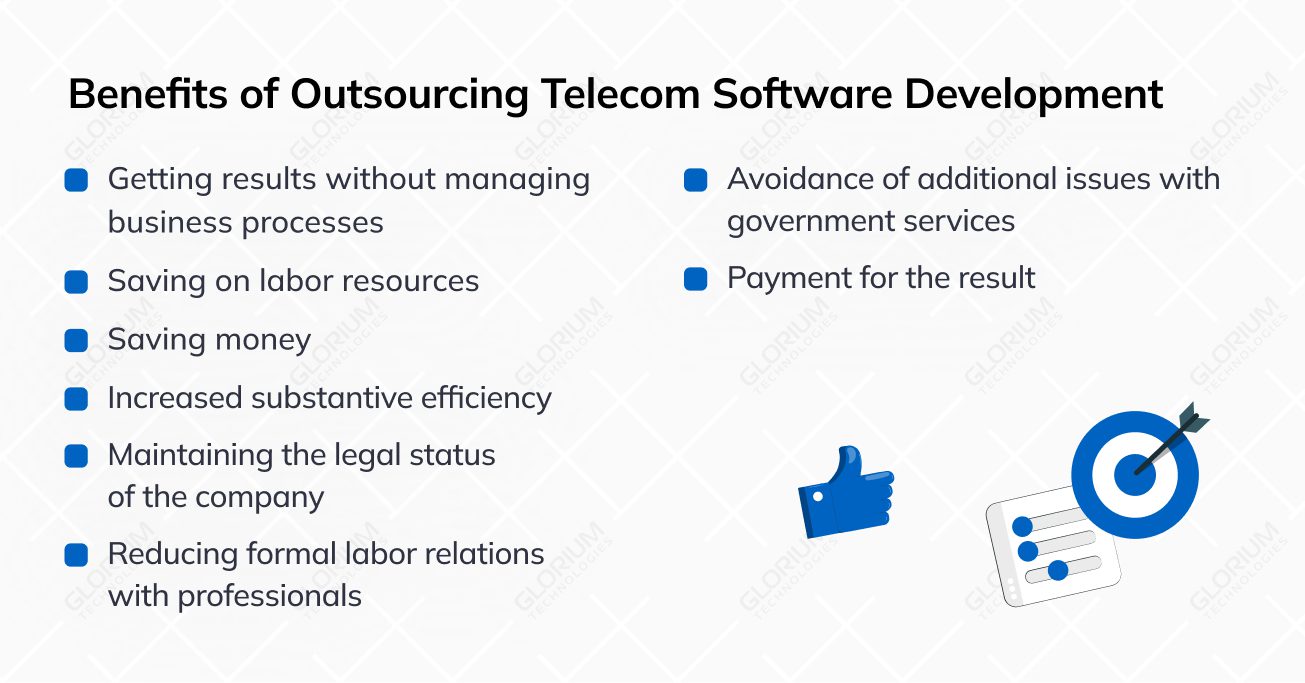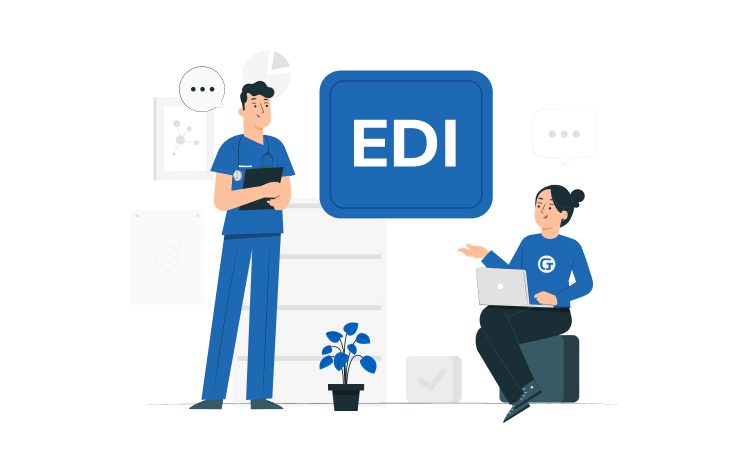
Telecommunications Software Development: a Complete Guide



Telecommunications technology is part of our daily routines. Each time you open your smartphone, it quietly springs into action. Whether you are ordering takeout or making a payment, your device connects to servers and banks, sending requests and receiving responses in seconds — all through invisible networks working behind the scenes.
Content
Let’s explore the latest trends in telecom software development, which are shaping the future of how we communicate and manage networks.
A pivotal tendency in the telecom sector is using Software-Defined Networking and Network Function Virtualization. These technologies are meant to reform operational frameworks – hardware dependency gives way to software agility.
The era of physical equipment is over. With NFV, telecom providers can deliver and manage telecommunication services through software alone. This approach lowers operational costs while making it easier to adjust and expand services as demand grows.
SDN transforms network management by separating the control and data planes. Providers can get precise control over operations and handle growing traffic volumes and service demands. When combined with NFV, SDN is changing how modern telecom systems are built and managed, making them more efficient and scalable.
Today, nobody is surprised by using artificial intelligence and machine learning in telecom software development. These technologies are driving advancements across several critical areas:
Telecom service providers turn to low-code and no-code tools to speed up application development as they:

Application Programming Interfaces provide new opportunities for collaboration and innovation. These APIs allow:
The telecommunications sector generates a lot of network traffic. Here, advanced data analytics is a must-have. To gain meaningful insights and keep customer satisfaction high, telecom companies turn to specialized software that:
Blockchain technology, famous for its uncompromising security and transparency, is making its way into telecommunications. It is ideal for:
Today, businesses can choose between ready-made software designed for broad industry use and bespoke software solutions built around specific needs. Custom telecom software development focuses on creating a unique operating system that addresses particular challenges or goals of the company.
Cookie-cutter alternatives come with general functionality, making them useful for a wide range of enterprises. You should invest in one-off solution when you need to automate certain processes or when it might give you a leg up.
Ready-made telecommunications solutions can be enough to perform day-to-day operations. You can use them for market testing and running pilot projects when you are doubting some ideas and want to validate their feasibility. However, companies aiming for growth and long-term expansion shouldn’t rely on generic solutions for core operations. Competing at the top level calls for ongoing innovation and the ability to launch new services/ products quickly. Prepackaged software often falls short of the flexibility essential for meeting those demands.
The standard solution comes ready-made; it does not allow you to apply changes or add new features.
When is your business suitable for a “ready” software solution?
Let’s learn more about an off-the-shelf solution’s advantages and disadvantages.
Off-the-shelf solution pros and cons
| Quick start Only 2-3 months to launch | Lack of control Due to pre-existing software |
| Minimum in-house development Only back-end support needed | Compatibility Not always meeting your needs |
| Simple implementation No significant effort required | Scalability. The solution’s capacity & your expansion plans may not match |
| Cost saving Price starting from $1K | Higher long-term costs For upgrades and so on |
A custom solution is a program designed for the company with specific business processes.
Telecom software development is preceded by a long analytics process. The success of business automation largely depends on this process’s results.
Custom software development pros and cons
| Unique solution Meeting all your business needs | Higher development costs As you create a new solution from scratch |
| Flexibility Your solution will grow with your company | Slow start Business analysis and development require more time |
| Security Own code and data protection | Maintenance and support Requires effort from your team |
| Compatibility You adapt the solution’s integration ability |
Glorium Technologies is your go-to place to address both operational and business support needs, as our customized systems are designed to do just that. From intelligent data-driven tools to robust integrations, our solutions help telecom providers improve performance and service delivery while remaining adaptive to changes.
Glorium Technologies excels at building and upgrading OSS for the telecommunications industry. Our solutions encompass performance monitoring and management tools so you can benefit from optimal network functionality.
We also deliver advanced trouble ticketing solutions that streamline issue resolution and ensure faster response times. In addition, we develop powerful network resource inventory management systems to ensure effective tracking and deployment of network resources.
Beyond that, our team creates cutting-edge billing software, fraud detection systems, and fault management solutions to improve service quality, boost operational control, and support telecom providers in meeting evolving demands.
At Glorium Technologies, we’ve got the knack of BSS. Our developers can create CRM platforms and enterprise resource planning software to improve resource allocation and operation control. Our services cover an array of essential tools — from task and document management to billing, accounting, and subscription plan management systems. We also design corporate portals and HR systems to improve internal workflows. If you are interested in bespoke digital solutions, we can develop custom web and mobile applications to enhance operational agility and automate key processes.
Glorium Technologies builds powerful data management systems that can quickly process large volumes of information. Our advanced visualization tools clarify complex analytics and support actionable outcomes, enabling you to turn raw data into meaningful findings.
Our team develops flexible reporting software and predictive analytics platforms that offer valuable forecasts to guide strategic planning. We also work on data mining and processing technologies and data warehousing cost optimization.
How do I decide? Before choosing between ready-made and custom telecom development software, consider the following elements:

If you want your business to be a success story in the long run, you need to balance what customers expect with creating a positive, lasting impression. An eye-catching, well-designed app can serve as a dynamic representation of your brand, attracting new users and cementing your market presence.
Ownership of code and independence from third-party developers reduces risks. When selecting a custom solution, the customer owns the code. When employing the box solution, you are merely renting it. Marketing draws clients to a platform the organization cannot control or influence – states Lina Lugova, CMO at Epom.
Outsourcing development allows for the precise transfer of code and documentation. It even allows the training of customer personnel for telecom software development and operation when the project is in-house. Only you will have access to your customers’ behaviors and business information.
Additional external integration, such as technical support, will be impossible or prohibitively expensive if you choose an off-the-shelf solution. A custom application’s average development and output time are 2-3 weeks. You can implement minor urgent enhancements (for example, holiday design modifications) in a few days.
You should determine your business’s operational gaps. What do you want the software to help you with? It can be about improving network performance or customer support. Or you might want to do both. Don’t home in on current demands but factor in future growth plans. The outline of these priorities makes for a strong foundation for the telecom software development process.
The telecom industry has regulations and standards you need to learn about to guarantee compliance. Evolving technologies—AI and NFV/SDN—can add value to your solution. Thorough research enables smarter choices when defining software functionality and potential. When you stay compliant from the start, you can avoid costly legal and operational issues in the future.
Cherry-pick tools and frameworks that support both front-end and back-end development, focusing on future growth and easy integration. On the back end, this may include databases and server infrastructure, while front-end decisions should prioritize user interface and experience. Scalability ensures your solution can evolve alongside your business, and strong integration capabilities make connecting with current telecom systems easier.
Based on your project’s complexity and resource availability, decide whether to use an in-house team or outsource to external experts. If the latter option speaks to you, look for a company with multiple specialists, including QA engineers and UX/UI designers, on board. Make sure they have 4+ years of experience in telecom-specific software development.
You should develop an early-stage prototype to demonstrate the main functionalities and the user interface to stakeholders and end-users to collect valuable input. Refining the design through ongoing feedback ensures the final solution meets real-world needs and expectations.
Carry out detailed testing at every stage — from unit and integration to system and user acceptance — to validate the software’s performance and stability. Applying agile practices helps adjust to evolving requirements throughout development. Rigorous testing reduces errors and contributes to a better user experience.
You need to carefully deploy the software in a controlled environment to monitor its initial performance. Focus on aligning it smoothly with existing telecom infrastructure to maintain service continuity. A well-planned deployment reduces operational risks, while proper integration strengthens overall system performance.
Provide comprehensive training to users for effective software adoption and utilization. Training helps in maximizing the benefits of the new software. Continuous support enhances user confidence and software reliability.
Around 64% of IT leaders outsource their software development projects to access a talent pool of specialized developers and reduce costs.
Outsourcing telecom software development might be an excellent approach to saving time and recruiting professional specialists. External management usually benefits a business owner who decides to outsource specific procedures to contractors. Your project will go further by hiring an expert in your field.

Supposing you choose custom development. What should you do next?
There is an increasing number of outsourcing companies in the niche. They provide nearly identical services and talk about similar topics on their websites. They are all “leading,” “experienced,” “renowned” and guarantee an “unprecedented advantage.” So, how do you pick professionals for digital transformation?

Before making a final decision, visit the company’s website to learn more about its method and case studies. The portfolio typically reflects the company’s experience and project skills. If you can’t find this information, it might suggest that the company or its clients weren’t happy with the completed projects. Keep on looking.
Reviews can reveal a lot — if you know where to look. You can stop by Clutch.co. This website enables software companies to showcase their previous work and accomplishments. Niche forums and social media groups can also be great sources of information.
Before contacting telecom software developers, create a technical assignment outlining the workload. Decide which parts of the project you want to delegate and what you’ll manage on your own. It’s up to you to set clear goals and determine the best path forward. A good starting point is to ask yourself key questions: What issue are you trying to solve? What solution do you have in mind?
Answering these helps to:
Decide how much you are able to invest in your upcoming project based on the scope of work and your business goals. A clear budget helps avoid unrealistic expectations. Once you have ballpark figures in mind, talk to potential partners about the budget you’ve set.
When looking for a partner to cooperate with, pay attention to:
A company with a limited tech stack can restrict your project’s potential, while teams experienced in multiple technologies are more likely to build well-architected software.

By carefully analyzing market trends and recognizing the specific needs of the medical community, Glorium Technologies can transform a concept into a top-of-the-line digital solution.
Our recent project was devoted to building an extended social networking platform for healthcare professionals. Originally, it was envisioned as an AI-enabled medical number and image recognition tool, but the concept was quickly modified. We’ve created a comprehensive platform — a kind of “Google for medicine” — that not only delivers specialized tools but also curates the latest industry news, fostering a dynamic professional community.
Key features and technical details:
The app was built around four core functions: visualization, exploration, learning, and sharing knowledge. This makes it more than just a tool. Our app is a go-to hub for medical professionals — a place to connect, access critical information, expand knowledge, and more.
By applying our expertise in AI, big data, secure communications, and user-centered design, we’ve created a solution that transforms professional interaction within the healthcare industry. This project reflects our strength in developing personalized telecom software that meets specific industry demands while seamlessly incorporating advanced technologies.
Are you in the market for high-quality telecom software solutions? Look no further than Glorium Technologies. With a dedicated development team, we can undertake any project, no matter how sophisticated it may seem. Our experts can handle the whole process, undertaking multi-stage testing and deployment.
Whether you need a custom telecom platform or advanced integrations, we’re here to help. Let’s build together the telecom solution you envision! Submit your request, and our specialists will be in touch soon.
It is designed to manage and coordinate electronic data exchange across various communication channels, like text, voice, and video. It is responsible for ensuring seamless connectivity and supporting telecommunications operations.
Your business may benefit from a cookie-cutter software solution if operations are straightforward or you have some budget constraints. However, for more complex processes and scalability perspectives, custom software development is the better choice.
Custom software development is a unique solution created for a particular customer’s needs. You can delegate the software development to the outsourcing company.
Check the company’s website and case studies. You can also drop by Clutch for reviews. The web is full of discussion forums and social networks that can come in handy. Pay attention to whether previous clients were satisfied with the process’s efficiency and the final results.








